Sept to Dec 2023 Edition 2023 State Conference Recap Session 5: Yakima Integrated Plan - Accomplishments & Next Steps Summary by Jenna Mandell-Rice, Partner at Van Ness Feldman LLP, Seattle Office Session 5 of the State Conference was a panel discussion with representatives from stakeholders in the Yakima Basin Integrated Plan. Panelists included Richard Visser, U.S. Bureau of Reclamation; Tom Tebb, Washington State Department of Ecology; Steve Malloch, Western Water Futures; Walt Larrick, Yakima Basin Irrigation District; and Danielle Squeochs, Yakama Nation. The panelists discussed the accomplishments of the Plan between 2013-2023. Notable accomplishments include conservation of 59,306 AF of water, the completion of the Cle Elum Pool Raise, the Springwood reservoir site acquisition, the Wapato Irrigation Project Modernization Plan, competition of Sunnyside interim fish passage project, more than 40 restoration projects, and acquisition of 62,375 acres for habitat restoration, among other things. The panelists also discussed drought conditions in 2023 and responses to the drought under the plan. The drought conditions appeared late in the spring after many agricultural decisions had already been made. In response to the drought, irrigation districts ended the irrigation season early and were subject to delivery restrictions. The panelists provided an overview of the goals of the Yakima Basin Integrated Plan and the approaches that the stakeholders have used to achieve those goals. One goal of the plan is reliable irrigation supply, with a target of providing proratable irrigators with 70% of their supply in drought years. A related goal is to increase municipal and industrial water supply. To achieve these goals, the stakeholders have implemented water conservation, water management efficiency, and surface and groundwater storage projects. The panelists provided updates regarding water storage projects, including the Kachess Drought Relief Pumping Plant, the Springwood Reservoir, the Bumping Dam & Reservoir Enlargement, the North Fork Cowiche Creek Reservoir, and groundwater storage projects. A second goal of the Yakima Basin Integrated Plan is a self-sustaining harvestable fish population. To achieve this goal, the stakeholders are focused on fish passage, flow augmentation, and habitat restoration projects. The panelists discussed progress on the Tieton Fish Passage Complex; the Cle Elum Dam Fish Passage Project, which is anticipated to be operational in 2026; the Cle Elum Pool Raise, which is targeted for completion in 2026/2027 and would provide 14,600 AF of water for fisheries purposes; and a variety of lower Yakima River Diversion Dam passage improvements.
|



